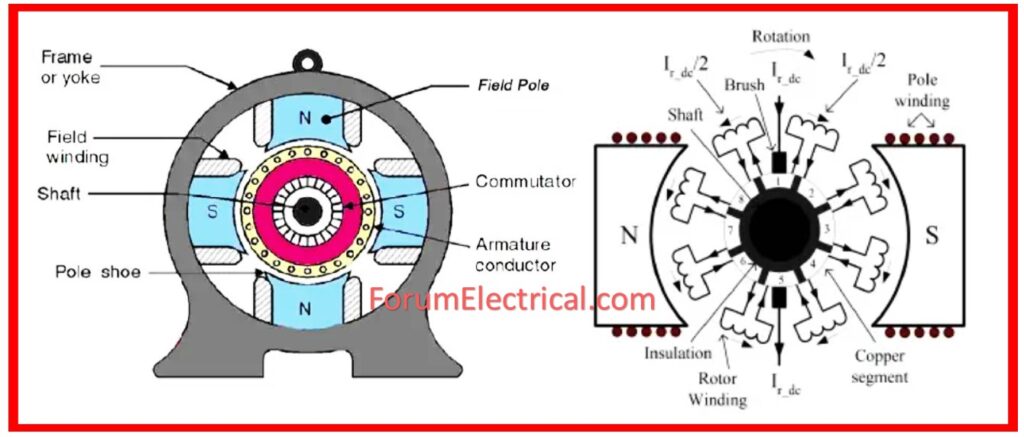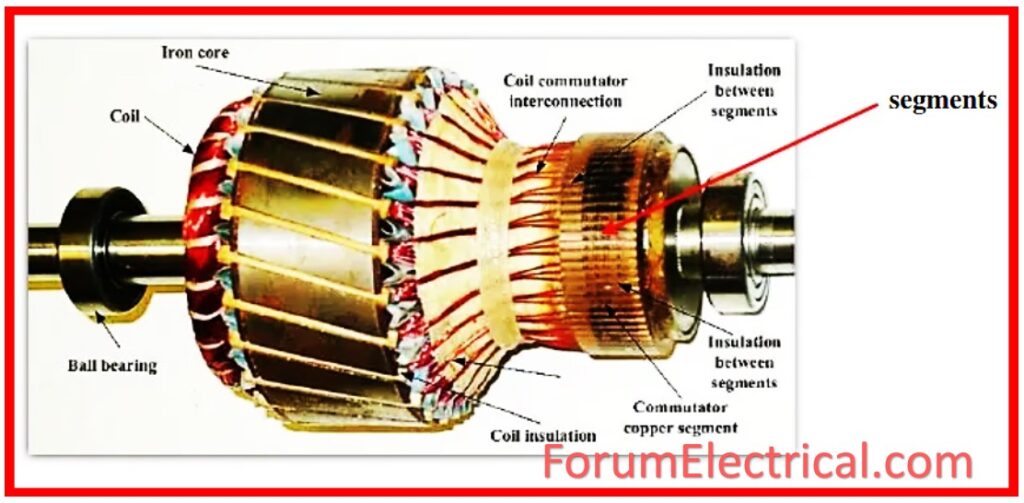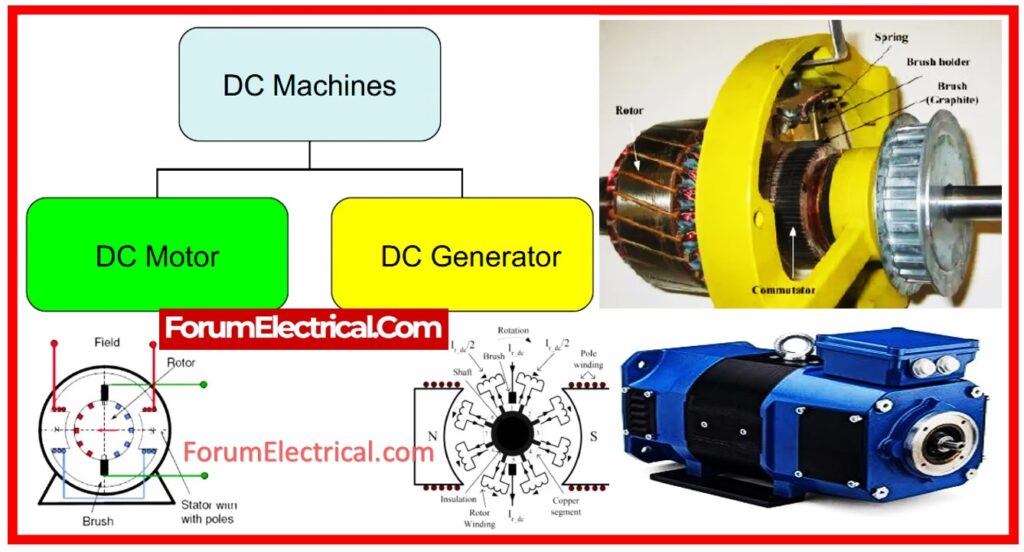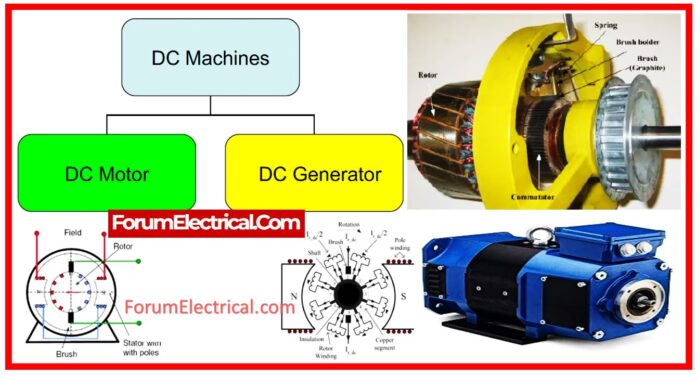DC Machine
An electrical machine is an electrical device that transforms mechanical energy converted into electrical energy and vice versa.
- DC Machine
- Types of DC Machines
- DC Generator
- DC Motor
- Maintenance of DC Machine
- Armature Maintenance
- Field Coil Maintenance
- Commutator Maintenance
- General Maintenance
- Noise & Vibration Inspections
- Visual Inspections
- Bearings: Replacement & Lubrication
- Armature Winding/Commutator Defects
- Open Circuit Fault
- Short Circuit Fault
- Earth Fault
- Causes of Sparking in Commutator
- Troubleshooting of DC Machine
- 1). DC Generator Voltage Failure
- 2). Low DC Generator Output Voltage
- 3). High DC Generator Output Voltage
- 4). Armature Heat
- 5). Field Coils Heat
- 6). Sparking at Brushes
DC motors are now widely used in electric traction and industries.
In Industry, periodic maintenance is necessary for minimizing plant downtime.
Types of DC Machines
DC machines are grouped into two types:
- DC Generator and
- DC Motor.
NEMA MG-1: National Electrical Manufacturers Association (NEMA) specifications for motors and generators.
DC Generator
Electrical generators are revolving machines that convert mechanical energy into electrical energy.
The energy conversion is based on electromagnetic induction.
According to Faraday’s law of electromagnetic Induction occurs when a conductor moves in a magnetic field, resulting in dynamically induced e.m.f.
IS 4722: Indian Standard for Rotating Electrical Machines (including DC machines)
DC Motor
The fundamental concept of the functioning of the DC motor is that anytime a current carrying conductor is put in a magnetic field, it attains a force that tends to move it.
Maintenance of DC Machine
Maintenance which includes electrical testing & visual inspection of the armature, commutator, brushes, & filed coils.
Insulation to ground testing on DC equipment to determine the state of insulation.
Checking brushes & commutator status are highly essential aspects of maintenance of DC machines.

Armature Maintenance
Visual inspection of the armature should include the check for the cracked (or) brittle insulation, loose (or) broken bands & any dirt (or) oil contamination.
Leakage to ground testing of armature reveals insulation condition.
A bar-to-bar resistance check may detect shorted windings (or) bad solder connections at the risers.
Infrared testing of the armature may detect overheating of the brushes, commutator, loose (or) hot connections on the risers.
Field Coil Maintenance
Visual inspection of field coils reveals broken or brittle insulation.
Leakage testing measures insulation level.
Drop tests are used to identify shorted windings.
The field leads receive 110 V alternating current. The voltage drop across every field pole is measured using a voltmeter. A healthy motor should have similar voltage decreases.
Commutator Maintenance
Inspect the commutator surface, brush, and brush holder tension.
High Mica
- Mica is utilized as insulation between commutator segments.
- Mica should be about 1/16″ < the surrounding commutator bars.
- Wearing the commutator bars causes brush chatter. Laying the dumb end of a lead pencil (or) other insulated instrument on a brush while the motor is moving and feeling for vibration can reveal this.
High Commutator Bars
- Typically caused by the wedge (or) wedge ring.
General Maintenance
Noise & Vibration Inspections
(or) shorted windings or unequal air gaps, in addition to mechanical issues. To troubleshoot an electrical problem from a mechanical imbalance, start the motor and then turn off the power.
If the noise/vibration remains when it is unpowered, the issue is mechanical; if the noise ceases once power is unplugged, the problem is likely electrical.
Visual Inspections
Visual inspections assess the physical condition of a de-energized machine and record any irregularities found.
A machine that seems dusty, rusted, or “beat up” suggests that it was used in a harsh environment & may have more issues than typical.
The testing should include a “smell” test. Is there a burning smell coming from the machine’s windings, the burned odor comes from the insulating varnish on the machine’s windings.

In this case, there may be a fault with the overheating. Machine winding damage is probable under these conditions, hence winding tests should be performed.
Bearings: Replacement & Lubrication
Machine bearing maintenance tasks include cleaning, removal, and replacement in addition to lubrication.
Bearings should have been checked for anomalous sounds, vibrations, and hot bearings during the noise & vibration inspections.
Basic methods for assessing bearing condition include the “feel” & “sound” tests.
Touch the bearing housing while the machine is running to conduct the “feel” test.
If the bearing is really hot to the touch, it is most likely faulty. During the “sound” test, listen for pounding or grinding sounds.
If it exist, the bearings should be checked carefully and replaced if necessary. Most forms of bearing failures are caused by:
- Insufficient oil (or) grease.
- Excessive grease causes churning and overheating.
- Worn bearings (such as shattered balls/rough races, etc.)
- A hot machine (or) external environment.
IEC 60034: International Electrotechnical Commission (IEC) Standard for Rotating Machines
Armature Winding/Commutator Defects
The type of faults that arises in armature winding are:
- Open Circuit Fault,
- Short Circuit Fault and
- Earth Fault (Or) Ground Fault
Open Circuit Fault
This occurs when armature conductors are damaged or a junction with the commutator pulls out.
Short Circuit Fault
If the insulation across armature conductors suffers failure, a current flow between them. This is termed a short circuit.
Earth Fault
Failure of armature conductor & slot insulation may result in faulty current flowing from the conductor to the motor, causing it to not start. This fault is known as the earth fault.
Causes of Sparking in Commutator
Sparking happens for the following reasons:
- Overloading.
- Brushes may get stuck in the holders.
- Spring pressure may be insufficient.
- Burning may occur on the edges.
- The commutator surface can be rough, with high bars.
- The grade of carbon brushes can be inaccurate.
- High levels of mica may be present in the slots. Brushes will wear quickly with high mica.
- Excessive pressure on the some brushes might cause sparks.
- Brushes may be too slack in holders.
- Pigtails can be loose in same brushes.
- Defects in armature & field circuits may also cause sparking.
- An open circuit in commutator riser will result in a brilliant flying spark.
Troubleshooting of DC Machine
1). DC Generator Voltage Failure
Cause:
- Faulty voltmeter, test output voltage separately. Open-field resistor.
- Test coils for loose connections or open circuits.
- No residual magnetism in self-excited generators.
- Dirt commutator, high mica, and poor brush contact.
- New brushes seated yet not covering enough.
- Internally shorted armature to ground.
Solution:
- Change voltmeter. Repair or replace resistor
- Replace broken coils and tighten (or) solder loose connections.
- Flash field. Connect batteries to a field with proper polarity, permit current, then cut off. The field regains magnetism.
- Commutators clean or dress inside cut mica.
- Brush replacement is free if holders are bound.
- Reseat brushes and brush bedding. Repair or replace, test, eliminate.
2). Low DC Generator Output Voltage
Cause:
- Ground (or) shorted field coil.
- Shorted filter capacitor & open filter choke
- Open ammeter shunt & damaged brush shunts.
- Low prime mover speed (test).
- Brushes not seated correctly. Commutator unclean, or film extremely heavy.
Solution:
- Check, fix, replace prime mover & governor adjustment. Reseat brushes.
- Sand commutator finely. Replace brushes with graded ones.
- Completely new brushes
- Adjust properly and connect appropriately.

3). High DC Generator Output Voltage
Cause:
- An incorrectly set field resistor.
- Reversed field/armature coil connections.
- High prime mover speed.
- Possible voltage regulator failure or overload.
Solution:
- Adapt regulator.
- Adjust or replace malfunctioning voltage regulators.
- Test speed.
4). Armature Heat
Cause:
- Check name plate ratings versus meter readings.
- High brush pressure.
- Tight belt or misaligned coupler.
- Unpositioned end plate. A bent shaft.
- Armature coil cut armature hitting poles.
- Check bearing play.
- Air gap spacing, & shaft bend.
- Poor ventilation.
- Airflow obstruction.
- Multiple load changes in bulk.
- Check meter reading.
Solution:
- Lower burden.
- Replace tension springs or adjust pressure.
- Adjust belt.
- Correctly align units.
- Correctly assemble.
- Replace or lathe straighten.
- Replace or repair armature. Get new bearings.
- Replace or straighten shaft Armature.
- Unclog airpassages.
- Give clearance for equipment air circulation. Clean gear.
- Generators should be used for stable load.
5). Field Coils Heat
Cause:
- Coils may be short or grounded.
- Overload (compound generator) – compare meter readings against name plate data.
- Poor ventilation.
Solution:
- Replace shorted coils and fix grounded coils.
- Clean congested air channels.
- Allow for air movement around equipment.
- Reduce load.
6). Sparking at Brushes
Cause:
- Brushes off the neutral plane.
- Brushes are not positioned correctly.
- Dirty brushes & commutator
- High mica, Rough (or) eccentric commutator.
- Open in armature
- Grounded.
- Open (or) shorted field winding
- Lack of brush pressure.
- Brushes stuck in holder
- Selective commutation produced by uneven brush tension
- Open circuit in field rheostat.
Solution:
- Set rigging so, that brushes are in proper plane.
- Clean and resurface commutator.
- Repair (or) replace armature.
- Repair (or) replace damaged coil/coils.
- Replace and clean tension springs and holders.
- Adjust spring tension.
- Replace brushes (or) shunts.
- Replace (or) repair the rheostat.
Adherence to international standards, regular inspection, and prompt corrective measures are all necessary for effective DC machine maintenance and troubleshooting.
Potential failures may be reduced by following standardized methods, resulting in dependable and long-lasting machine performance.
A preventative maintenance approach, paired with expert diagnostic skills, may significantly minimize downtime and increase productivity.






